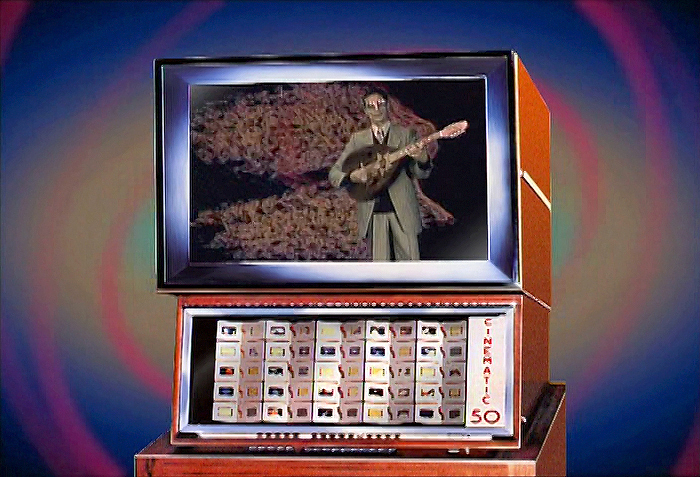
Screening this evening, Treasures of the Scopitones shows an exciting history of a rare group of music films created by North African immigrants to France in the 1960s and early ’70s. Co-director Michèle Collery will be on hand to discuss the film at 7:30 pm. Full songs from Treasures of the Scopitones are playing in a scopitone on view in the exhibition Album: Cinematheque Tangier, a project by Yto Barrada through May 18, 2014.
In 1996 Michèle Collery and Anaïs Prosaïc browsed the musical archives of Daidy Davis-Boyer, a well-known music producer working in the 1960s, researching for a documentary about a Sephardic song called “The Crooners of the Casbah.” Davis-Boyer shot hundreds of scopitones — short movies created for a jukebox that projected 16mm on a small screen — and stored the less-in-demand negatives in her garage. Collery and Prosaïc noticed four boxes of 16 and 35mm reels in the corner; seemingly abandoned, the boxes were labeled “Arab.” The two already made documentaries about Arab music and culture and knew about the legendary scopitones that disappeared from circulation after running in Parisian cafes in the ’60s and ’70s. The scopitone was invented by a firm called Compagnie des Applications Mécaniques et Électroniques au Cinéma et à l’Atomistique (CAMECA) in the early 1960s. Café patrons wishing to see one slipped a coin into the machines which then played filmed songs.
After interviewing Davis-Boyer, they found these negatives were music films shown in suburban Paris cafés where many North African immigrant workers gathered to gather, talk, and watch the musical endeavors of artists from their communities. Davis-Boyer deemed the reels uninteresting to audiences and now worthless to her, so Collery and Prosaïc received them as a gift. Viewing them on a projector confirmed they were the disappearing scopitones, produced in France (not in an Arab country) by Davis-Boyer.
Collery told me her interest in making films about Arab culture stems from her travel to many Arab countries — Algeria, Morocco, Syria, Jordan, Lebanon — and from living in Tunisia and Qatar. Her radio show in Qatar about Francophone culture allowed her to introduce Algerian, Moroccan, and Tunisian songs the people there never heard. She knew to make an aesthetically pleasing documentary, she needed strong archival images to pair with the songs. “What attracted us [to the reels] is the socio-political element of songs telling stories about the mentality or evolution of a time now outdated … some sequences remind me of West Side Story or Fellini’s films,” Collery said.
The scopitones themselves magically pinpoint the problems affecting North African immigrants of the time — sadness over exile, racism, unemployment — through the poetic qualities, political consciousness, and modernity of the videos’ singers. Songs danced solely by women bear the lyrics, “I’ll never get married. I love the single life too,” and a group called The Golden Hands displayed three Moroccans resembling Jimi Hendrix on guitar. The expression of sexual freedom and ability to make rock ‘n’roll entirely debunked the perceptions other countries held of North Africans.
The singers and their descendants gathering in the café to re-watch these musical productions in Collery and Prosaïc’s documentary carefully point out there are “songs also about country, family, friendship, and fraternity … not just exile and separation.” In one, the popular group Idir dances around a sunny park, jubilantly singing, “women wear new garb and even men begin to dance … everyone is dancing, let yourself go, have a ball.” These videos are markers of the originality of North African singers and their insistence to have a good time amid other struggles.
From choosing the scopitones of best quality to finding interested producers in the company Canal+, Collery and Prosaïc shot the film in two days after contacting the singers through their record companies. Due to the lengthy process of gaining copyright to broadcasting rights, the total process took two and a half years.
Filming the reunion in the café was “a meeting full of surprises and warmth, very moving,” Collery said. Although there were generational gaps, the power of these people enjoying and engaging in part of the North African collective memory was immeasurable. The beauty of the selected scopitones with reactions from the café is what Collery believes “revives and introduces children and grandchilden of these immigrants to show the culture of their parents was not limited to the mosque and the land.”
The initial reception was successful in France, and Collery remarked that “in Algeria, it shocked some people … but in general the audiences were surprised and proud about the poetry, humor, and outspokenness of the writers.”
Get Walker Reader in your inbox. Sign up to receive first word about our original videos, commissioned essays, curatorial perspectives, and artist interviews.